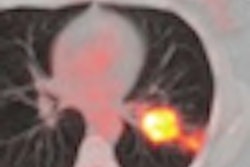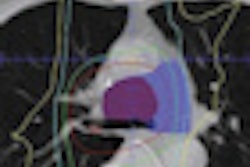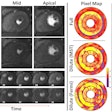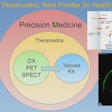SAN DIEGO - Researchers at this week's Society of Thoracic Surgeons (STS) meeting suggested that PET/CT scans alone may not be enough to identify metastases to the chest lymph nodes among patients being treated for non-small cell lung cancer.
In a retrospective analysis of patients treated with both fusion PET/CT and traditional dissection, the study group found that PET/CT had a specificity of 41% and a sensitivity of 51%.
The modality's positive predictive value was 68%, and its negative predictive value was 26%, reflecting the number of false negatives found in determining whether cancer had spread to the lymph nodes, according to Sergio Carrillo, MD, a clinical instructor in surgery at the James Comprehensive Cancer Center at Ohio State University in Columbus.
"Clinicians should look for additional ways to sample these lymph nodes," said Carrillo in presenting his data in a poster at the STS conference. "We believe that fusion PET/CT is an integral part of the perioperative workup of patients with non-small cell lung cancer. Those patients with an early clinical stage should proceed to be evaluated more thoroughly. Fusion PET/CT lacks sensitivity and specificity to identify N1 disease preoperatively."
Carrillo and colleagues scrutinized the records at Ohio State University Medical Center for patients who had undergone lung resection for non-small cell lung cancer with hilar and mediastinal lymphadenectomy from 2005 to 2008. All patients had dedicated dual-modality PET/CT (Biograph mCT, Siemens Healthcare, Malvern, PA) within 30 days of their surgery. Whole-body scans were performed within 75 minutes of injection with 15 mCi of F-18 FDG. Positive findings were compared to histopathology.
The findings were assessed by a nuclear medical physician who was unaware of patient outcomes. Patients were treated with standard thoracotomy or visually assisted thoracic surgery (VATS).
The researchers compared results among 41 patients (23 men and 18 women). The group had an average age of 60 years.
"The problem with PET/CT is that it appears to lack the ability to locate small but important metastases," said Nicholas Demos, MD, professor of medicine at the University of Medicine and Dentistry of New Jersey, in reviewing the presentation. "In order to properly diagnose whether cancer has spread to the lymph nodes, we still need to rely on pathological dissection."
Carrillo suggested that prospective studies assessing the utility of PET/CT versus alternative sampling techniques such as endobronchial ultrasound-guided fine-needle aspiration are warranted.
By Edward Susman
AuntMinnie.com contributing writer
February 3, 2011
Copyright © 2011 AuntMinnie.com




















